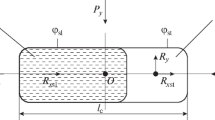Abstract
A new mathematical model of the oscillating processes of complex systems of elastically deformed solids with superimposed nonholonomic rheonomous constraints under random perturbation is discussed in regards to the contact (tribological) interaction of a wheel and a supporting surface, torsional wheel oscillations, and transmission as applied to multiple-seated wheeled vehicles. The results of the testing of a vehicle by means of a stand with chassis dynamometers in stationary and nonstationary modes of wheel rolling motion are given. The obtained regularities make it possible to depict the picture of oscillations of the system under consideration, which will help to formulate complex requirements for the active safety control systems of multiaxis wheeled vehicles in the future.
Similar content being viewed by others
References
Belousov, B.N., Kupreyanov, A.A., and Shelomkov, S.A., The Way to Control the Electric Transmission with Alternating Current Motors of Multiaxis All-Wheel-Drive Chassis, in Povyshenie konkurentosposobnosti avtotransportnykh sredstv. Sb. nauchnykh trudov NIRUP “Belavtotraktorostroenie” (Competitive Recovery of the Vehicles. Collection of Scientific Papers of NIRUP “Belavtotraktorostroenie”), Minsk, 2004, pp. 257–262.
Dik, A.B., Description of Slipping Parameters of Braking Wheel, in Sb. nauchnykh trudov “Nadezhnost’ i aktivnaya bezopasnost’ avtomobilya” (Collection of Scientific Papers “Reliability and Active Safety of a Car”), Moscow: MAMI, 1985.
Kupreyanov, A.A., Sharuev, D.A., and Shelomkov, S.A., The Way to Control the Power Fluxes in Vehicle Transmissions Taking into Account the Peculiarities of Contact Interaction and Tribological Properties of the System “Elastic Wheel — Carrying Surface”, Tribologiya i nadezhnost’, St.Petersburg, 2005, pp. 9–22.
Smirnov, G.A., Teoriya dvizheniya kolesnykh mashin (Theory of Motion of Wheel Machines), Moscow: Mashinostroenie, 1990.
Antonov, D.A., Teoriya dvizheniya boevykh kolesnykh mashin (Theory of Motion of Fighting Wheel Machines), Moscow: Izd-vo Minoborony, 1993.
Naumov, V.N., Batanov, A.F., and Rozhdestvenskii, Yu.L., Osnovy teorii prokhodimosti transportnykh vezdekhodov (Foundations of Transport All-Terrain Vehicles Practicability), Moscow: Izd-vo MVTU im. N.E. Baumana, 1988.
Platonov, V.F., Polnoprivodnye avtomobili (All-Wheel Drive Vehicles), Moscow: Mashinostroenie, 1989.
Smirnov, G.A., Teoriya dvizheniya kolesnykh mashin (Theory of Motion of Wheel Machines), Moscow: Mashinostroenie, 1990.
Pacejka, H.B. and Bakker, E., The Magic Formula Tire Mode, Proc. 1st Intern. Colloquium on Tire Models for Vehicle Dynamics Analysis, Amsterdam/Lisse, 1993, pp. 31–35.
Egorov, A.I. and Petrushov, V.A., On Rolling Radius and Skidding Coefficient of Elastic Wheel on the Ground, Avtomobil’naya promyshlennost’, 1976, no. 9, pp. 17–19.
Author information
Authors and Affiliations
Additional information
Original Russian Text © B.N. Belousov, S.A. Shelomkov, T.I. Ksenevich, A.A. Kupreyanov, 2009, published in Problemy Mashinostroeniya i Mashin, 2009, No. 5, pp. 101–106.
About this article
Cite this article
Belousov, B.N., Shelomkov, S.A., Ksenevich, T.I. et al. Experimental verification of a mathematical model of the wheel-supporting surface interaction during nonstationary rolling motion. J. Mach. Manuf. Reliab. 38, 501–505 (2009). https://doi.org/10.3103/S1052618809050161
Received:
Published:
Issue Date:
DOI: https://doi.org/10.3103/S1052618809050161




